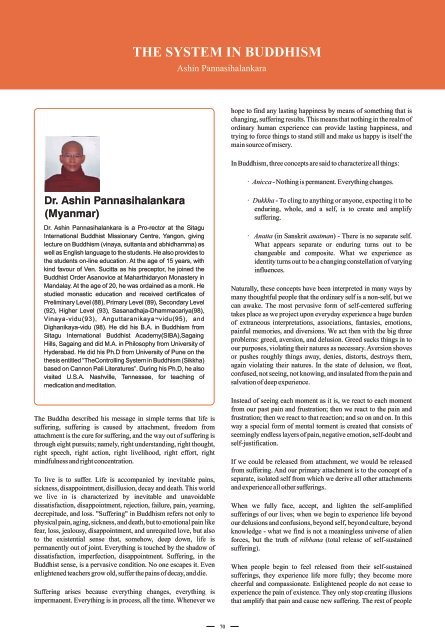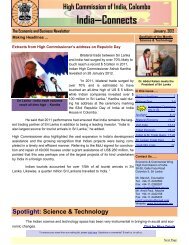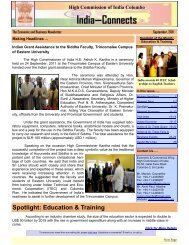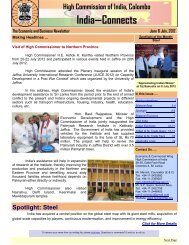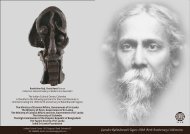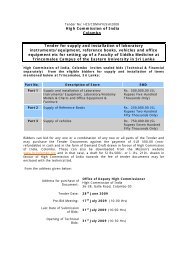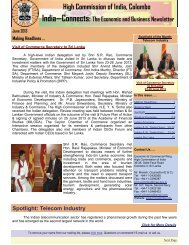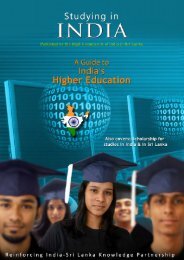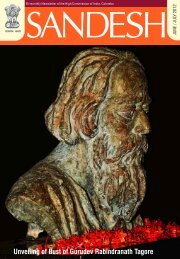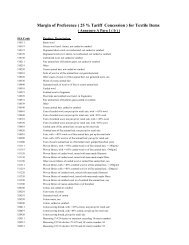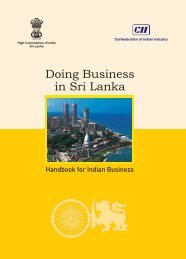Papers presented at the International Buddhist Conference, March ...
Papers presented at the International Buddhist Conference, March ...
Papers presented at the International Buddhist Conference, March ...
Create successful ePaper yourself
Turn your PDF publications into a flip-book with our unique Google optimized e-Paper software.
THE SYSTEM IN BUDDHISM<br />
Ashin Pannasihalankara<br />
hope to find any lasting happiness by means of something th<strong>at</strong> is<br />
changing, suffering results. This means th<strong>at</strong> nothing in <strong>the</strong> realm of<br />
ordinary human experience can provide lasting happiness, and<br />
trying to force things to stand still and make us happy is itself <strong>the</strong><br />
main source of misery.<br />
In Buddhism, three concepts are said to characterize all things:<br />
· Anicca - Nothing is permanent. Everything changes.<br />
Dr. Ashin Pannasihalankara<br />
(Myanmar)<br />
Dr. Ashin Pannasihalankara is a Pro-rector <strong>at</strong> <strong>the</strong> Sitagu<br />
Intern<strong>at</strong>ional <strong>Buddhist</strong> Missionary Centre, Yangon, giving<br />
lecture on Buddhism (vinaya, suttanta and abhidhamma) as<br />
well as English language to <strong>the</strong> students. He also provides to<br />
<strong>the</strong> students on-line educ<strong>at</strong>ion. At <strong>the</strong> age of 15 years, with<br />
kind favour of Ven. Sucitta as his preceptor, he joined <strong>the</strong><br />
<strong>Buddhist</strong> Order Asanovice <strong>at</strong> Maharthidaryon Monastery in<br />
Mandalay. At <strong>the</strong> age of 20, he was ordained as a monk. He<br />
studied monastic educ<strong>at</strong>ion and received certific<strong>at</strong>es of<br />
Preliminary Level (88), Primary Level (89), Secondary Level<br />
(92), Higher Level (93), Sasanadhaja-Dhammacariya(98),<br />
Vinaya-vidu(93), Anguttaranikaya¬vidu(95), and<br />
Dighanikaya-vidu (98). He did his B.A. in Buddhism from<br />
Sitagu Intern<strong>at</strong>ional <strong>Buddhist</strong> Academy(SIBA),Sagaing<br />
Hills, Sagaing and did M.A. in Philosophy from University of<br />
Hyderabad. He did his Ph.D from University of Pune on <strong>the</strong><br />
<strong>the</strong>sis entitled “TheControlling System in Buddhism (Sikkha)<br />
based on Cannon Pali Liter<strong>at</strong>ures”. During his Ph.D, he also<br />
visited U.S.A. Nashville, Tennessee, for teaching of<br />
medic<strong>at</strong>ion and medit<strong>at</strong>ion.<br />
The Buddha described his message in simple terms th<strong>at</strong> life is<br />
suffering, suffering is caused by <strong>at</strong>tachment, freedom from<br />
<strong>at</strong>tachment is <strong>the</strong> cure for suffering, and <strong>the</strong> way out of suffering is<br />
through eight pursuits; namely, right understanding, right thought,<br />
right speech, right action, right livelihood, right effort, right<br />
mindfulness and right concentr<strong>at</strong>ion.<br />
To live is to suffer. Life is accompanied by inevitable pains,<br />
sickness, disappointment, disillusion, decay and de<strong>at</strong>h. This world<br />
we live in is characterized by inevitable and unavoidable<br />
diss<strong>at</strong>isfaction, disappointment, rejection, failure, pain, yearning,<br />
decrepitude, and loss. "Suffering" in Buddhism refers not only to<br />
physical pain, aging, sickness, and de<strong>at</strong>h, but to emotional pain like<br />
fear, loss, jealousy, disappointment, and unrequited love, but also<br />
to <strong>the</strong> existential sense th<strong>at</strong>, somehow, deep down, life is<br />
permanently out of joint. Everything is touched by <strong>the</strong> shadow of<br />
diss<strong>at</strong>isfaction, imperfection, disappointment. Suffering, in <strong>the</strong><br />
<strong>Buddhist</strong> sense, is a pervasive condition. No one escapes it. Even<br />
enlightened teachers grow old, suffer <strong>the</strong> pains of decay, and die.<br />
Suffering arises because everything changes, everything is<br />
impermanent. Everything is in process, all <strong>the</strong> time. Whenever we<br />
· Dukkha - To cling to anything or anyone, expecting it to be<br />
enduring, whole, and a self, is to cre<strong>at</strong>e and amplify<br />
suffering.<br />
· An<strong>at</strong>ta (in Sanskrit an<strong>at</strong>man) - There is no separ<strong>at</strong>e self.<br />
Wh<strong>at</strong> appears separ<strong>at</strong>e or enduring turns out to be<br />
changeable and composite. Wh<strong>at</strong> we experience as<br />
identity turns out to be a changing constell<strong>at</strong>ion of varying<br />
influences.<br />
N<strong>at</strong>urally, <strong>the</strong>se concepts have been interpreted in many ways by<br />
many thoughtful people th<strong>at</strong> <strong>the</strong> ordinary self is a non-self, but we<br />
can awake. The most pervasive form of self-centered suffering<br />
takes place as we project upon everyday experience a huge burden<br />
of extraneous interpret<strong>at</strong>ions, associ<strong>at</strong>ions, fantasies, emotions,<br />
painful memories, and diversions. We act <strong>the</strong>n with <strong>the</strong> big three<br />
problems: greed, aversion, and delusion. Greed sucks things in to<br />
our purposes, viol<strong>at</strong>ing <strong>the</strong>ir n<strong>at</strong>ures as necessary. Aversion shoves<br />
or pushes roughly things away, denies, distorts, destroys <strong>the</strong>m,<br />
again viol<strong>at</strong>ing <strong>the</strong>ir n<strong>at</strong>ures. In <strong>the</strong> st<strong>at</strong>e of delusion, we flo<strong>at</strong>,<br />
confused, not seeing, not knowing, and insul<strong>at</strong>ed from <strong>the</strong> pain and<br />
salv<strong>at</strong>ion of deep experience.<br />
Instead of seeing each moment as it is, we react to each moment<br />
from our past pain and frustr<strong>at</strong>ion; <strong>the</strong>n we react to <strong>the</strong> pain and<br />
frustr<strong>at</strong>ion; <strong>the</strong>n we react to th<strong>at</strong> reaction; and so on and on. In this<br />
way a special form of mental torment is cre<strong>at</strong>ed th<strong>at</strong> consists of<br />
seemingly endless layers of pain, neg<strong>at</strong>ive emotion, self-doubt and<br />
self-justific<strong>at</strong>ion.<br />
If we could be released from <strong>at</strong>tachment, we would be released<br />
from suffering. And our primary <strong>at</strong>tachment is to <strong>the</strong> concept of a<br />
separ<strong>at</strong>e, isol<strong>at</strong>ed self from which we derive all o<strong>the</strong>r <strong>at</strong>tachments<br />
and experience all o<strong>the</strong>r sufferings.<br />
When we fully face, accept, and lighten <strong>the</strong> self-amplified<br />
sufferings of our lives; when we begin to experience life beyond<br />
our delusions and confusions, beyond self, beyond culture, beyond<br />
knowledge - wh<strong>at</strong> we find is not a meaningless universe of alien<br />
forces, but <strong>the</strong> truth of nibbana (total release of self-sustained<br />
suffering).<br />
When people begin to feel released from <strong>the</strong>ir self-sustained<br />
sufferings, <strong>the</strong>y experience life more fully; <strong>the</strong>y become more<br />
cheerful and compassion<strong>at</strong>e. Enlightened people do not cease to<br />
experience <strong>the</strong> pain of existence. They only stop cre<strong>at</strong>ing illusions<br />
th<strong>at</strong> amplify th<strong>at</strong> pain and cause new suffering. The rest of people<br />
70


